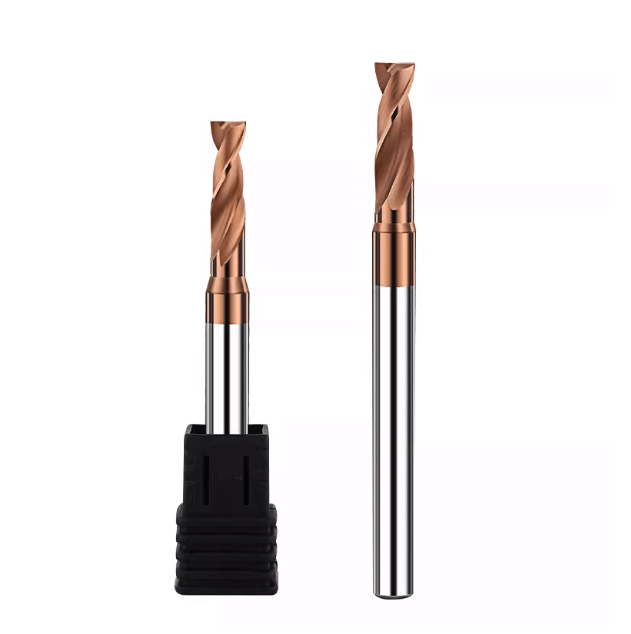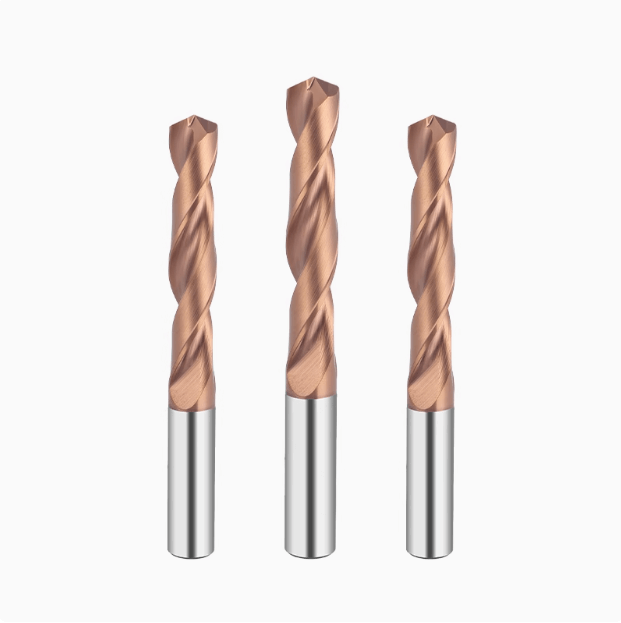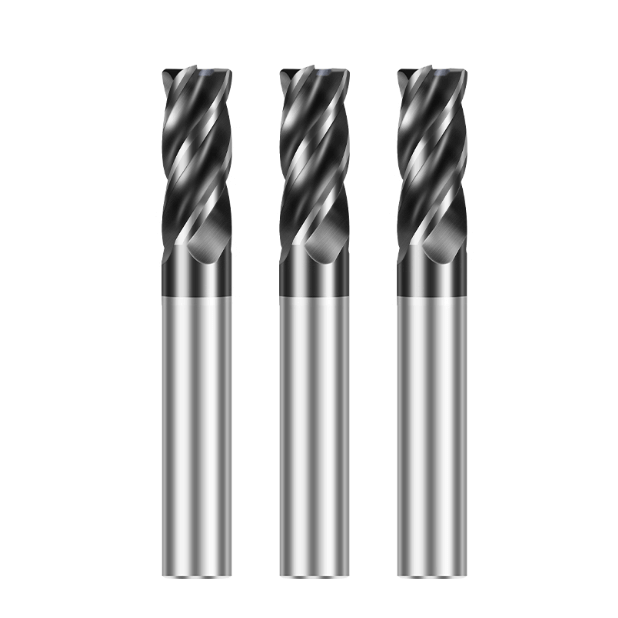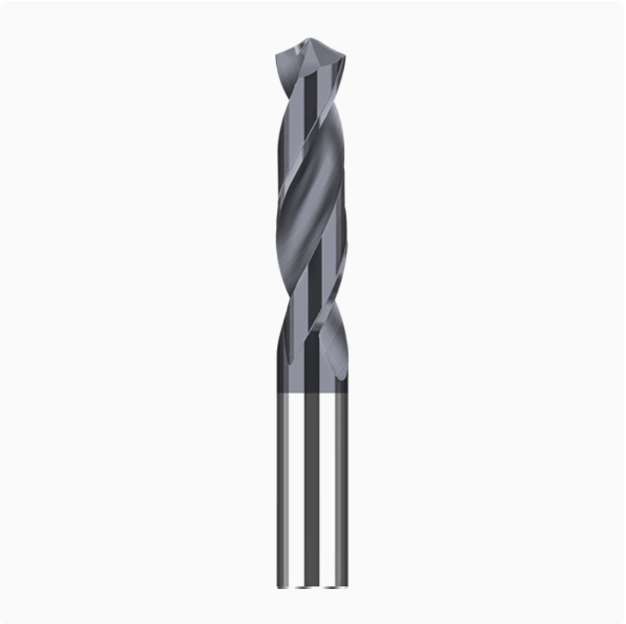Workpiece materials vary in their physical and cutting properties. Choosing the right type of drill bit is essential for maintaining hole accuracy, machining efficiency, and tool life. Whether it’s spot drill bits for high-precision hole placement, center drill bits for precise centering, or step drill bits for multi-diameter hole production, each drill bit type serves distinct applications and offers different cutting performance and material compatibility.
For challenging materials such as hardened steel, stainless steel, titanium alloys, or composites, standard drill bits often struggle to provide both efficiency and durability. In these cases, specialized drill bits for hardened steel or coated carbide drill bits help prevent chipping and burning. For parts with non-standard hole geometries or special depth requirements, standard drill bits may not suffice. Custom drill bits provide an ideal solution, ensuring production stability and machining consistency.
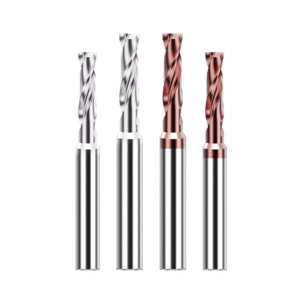
Understanding the Relationship Between Material Properties and Drill Bit Selection
The physical properties of materials—hardness, toughness, thermal conductivity, and ductility—directly affect cutting forces, temperature distribution, and tool wear. Choosing the right drill bit type and material is critical for efficient drilling and maintaining hole quality. Whether using carbide, cobalt, or custom drill bits, the tool must match the workpiece’s material characteristics.
When machining high-strength materials like hardened steel, stainless steel, or titanium alloys, drill bits must combine high hardness, wear resistance, and thermal stability with precise geometry to maintain hole diameter consistency. Conversely, softer materials such as aluminum, copper, and plastics require careful chip evacuation and anti-stick properties. Understanding these relationships helps engineers select the best drill bit type and coating, extending tool life and improving productivity.
Principles for Matching Material Hardness and Drill Wear Resistance
Harder materials increase cutting loads and thermal stress at the tool edge. Using low-hardness materials like standard HSS can quickly lead to edge wear or chipping. Carbide or cobalt drill bits offer higher wear resistance and more stable performance for high-hardness materials like mold steel or hardened steel.
Material hardness also affects cutting angles: hard materials need smaller point angles for edge strength, while softer materials benefit from larger angles to improve chip evacuation. Proper matching of drill material and geometry is key to prolonging tool life and preventing premature wear.
The Impact of Material Thermal Conductivity, Toughness, and Cooling Methods
Material thermal conductivity influences cutting temperature and heat dissipation. Poorly conductive materials such as stainless steel or titanium concentrate heat in the cutting zone, potentially causing high tool temperatures and burn marks. Drill bits for hardened steel with TiAlN or AlCrN coatings are ideal for these conditions, offering heat resistance and oxidation protection.
Tough materials like aluminum or copper, while easier to cut, are prone to chip sticking. Using drills with smooth flute surfaces and anti-stick coatings, along with mist or interrupted cooling, helps evacuate chips effectively. Selecting the right cooling method—dry, wet, or mist—based on material properties improves drilling stability and reduces thermal fatigue.
Adjusting Drill Bit Type Based on Hole Depth and Surface Finish
Hole depth and surface finish requirements also influence drill selection. Deep holes risk chip clogging with standard twist drills; carbide drills or step drill bits with internal cooling channels improve chip evacuation and cooling.
For through-holes, pre-drilling with standard twist drills or center drill bits ensures hole positioning. Blind holes benefit from drills with optimized cutting angles and short feed cycles to prevent chip accumulation. For higher surface finish or coaxiality, spot drill bits provide pre-positioning to reduce tool deflection and ensure consistent hole diameters. Proper tool selection and machining strategy are crucial for final hole quality and production efficiency.
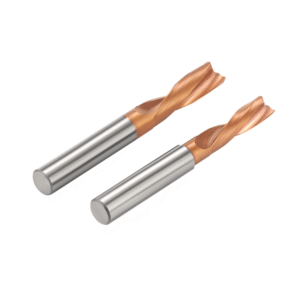
Common Types of Drill Bits Used in CNC Machining
In CNC machining, different drill types perform differently in terms of accuracy, cutting efficiency, chip evacuation, and tool life. Understanding the characteristics of various types of drill bits helps engineers select the best tool for specific materials, hole diameters, depths, and surface finish requirements.
Step drill bits are ideal for thin plates and multi-level hole machining, while spot drill bits and center drill bits provide precise positioning. For complex workpieces such as molds and aerospace components, tapered drill bits help maintain accurate countersinks and chamfers. Choosing the right drill bit type based on the machining task is essential for efficiency and consistency.
Spot Drill Bits – Ensuring Hole Position Accuracy
Spot drill bits are commonly used for pre-drilling. They create a small indentation at the hole center, preventing twist drills or center drills from wandering during startup. This improves hole concentricity and surface quality. Common angles include 90° and 120°, and lengths vary depending on workpiece thickness and hole depth. For high-precision applications, especially in precision molds or machined components, spot drill bits reduce tool wear and ensure accurate drilling.
Center Drill Bits – For Centering and Pre-Drilling
Center drill bits provide reliable centering and pre-drilling, particularly for turning operations. Unlike spot drills, center drills guide the subsequent lathe or milling operations, preventing chipping or hole offset. Selecting the correct drill size, controlling cutting speed and feed rate, and using coated or carbide drills for hard materials can significantly improve tool life and hole accuracy.
Step Drill Bits – Efficient Multi-Level Hole Production
Step drill bits allow drilling multiple hole diameters with a single tool, reducing tool changes and increasing efficiency. They are ideal for electrical panels, thin metal sheets, and custom multi-hole applications. Optimizing feed rates, spindle speed, and cooling is essential to prevent burrs, tool tip chipping, or hole distortion. Insufficient lubrication or excessive feed can compromise hole quality.
Tapered Drill Bits – Designed for Mold and Countersink Work
Tapered drill bits have a tapered cutting edge, enabling precise chamfering and bottom shape control. They are commonly used in molds, aerospace parts, and assembly holes. Selecting the correct taper angle and drill length ensures coaxiality and surface finish. Combining these bits with coolant channels or coated carbide drills improves tool life and process stability.

Choosing Drill Bits Based on Material Type
Different materials have unique cutting resistance, thermal conductivity, toughness, and hardness. Selecting the right type of drill bit and geometry is essential for ensuring hole accuracy, surface finish, and tool life. Properly matching drill bit types with the workpiece material can significantly reduce burrs, hole deflection, tool chipping, and thermal damage.
Whether machining thin plates, porous materials, or high-hardness steels, choosing the correct drill material, coating, and geometry is critical. For specialized holes or non-standard geometries, custom drill bits can provide enhanced stability and precision. The following sections provide practical drill bit selection strategies for different materials.
For Aluminum and Copper Alloys
When machining soft alloys like aluminum and copper, selecting the proper drill geometry and coating is crucial for stable performance. Aluminum and copper alloys are soft yet tough, with low cutting resistance but a tendency for chip adhesion. High-speed steel (HSS) drill bits or coated drill bits with larger rake and helix angles help ensure smooth chip evacuation and reduce material sticking.
For thin plates or small holes, spot drill bits can be used for accurate pre-positioning. Anti-chip coatings such as TiB₂ or DLC further reduce friction and adhesion, improving drilling stability and hole surface finish. Appropriate feed rates, spindle speeds, and chip evacuation techniques are key to efficient machining of these alloys.
For Stainless Steel and Titanium
Stainless steel and titanium alloys are high-strength, low thermal conductivity, and highly tough materials. These characteristics can cause heat concentration during drilling, leading to accelerated tool wear or burning. Coated carbide drill bits or drill bits designed with cutting edges to prevent sintering are suitable for these materials.
Controlling the cutting angle is crucial. A slightly smaller top angle (118°–130°) increases tool tip strength, while a moderate helix angle optimizes chip evacuation. TiAlN or AlCrN coated drill bits are recommended to enhance heat resistance and tool life. In combination with mist cooling or internal coolant channels, temperature control can be effectively maintained, ensuring hole accuracy and surface quality.
For Hardened Steel
Standard HSS drills often cannot meet the wear and heat resistance requirements for hardened steel or mold steel. Drill bits for hardened steel or carbide drills should be used. Carbide drills provide high hardness and excellent wear resistance, maintaining hole diameter accuracy under high load and speed conditions.
Coatings play a critical role: TiAlN or CVD diamond coatings enhance wear and high-temperature resistance. Cutting speed and feed rate should be carefully controlled, and appropriate cooling methods applied to reduce thermal fatigue and burrs at the hole bottom. For deep holes or non-standard shapes, custom drill bits can ensure precision and maintain tool life.
For Graphite, Composites, and Plastics
Graphite, composites, and plastics are brittle or prone to delamination, making hole wall spalling or fiber separation a common issue. Step drill bits designed for high-speed cutting or custom drill bits with burr-resistant edges are recommended for smooth cutting and consistent hole quality.
Drill geometry and chip evacuation are critical: small point angles, smooth flute surfaces, and appropriate helix angles reduce material adhesion and chip blockage. Rotational speed and feed rate should be adjusted according to the material to prevent heat buildup, plastic melting, or graphite dust accumulation, ensuring dimensional accuracy and surface finish.

When Standard Drill Bits Don’t Work — The Value of Custom Drill Bits
In actual machining, standard drill bits often fail to meet the specialized needs of complex hole operations. Workpieces may require non-standard diameters, deep holes, multi-step or special-shaped holes, or high-precision coaxiality. Relying on standard drill bits in these scenarios can lead to inefficiency, hole deviation, accelerated tool wear, or even scrap.
Custom drill bits are essential for addressing these challenges. By optimizing geometry, cutting edge angles, flute design, and coatings, they provide high precision, high efficiency, and extended tool life across various materials, including hardened steel, titanium alloys, and composites. In industries such as aerospace, precision molds, and medical devices, using custom drill bits effectively improves production stability and consistency while reducing overall costs.
Design Principles and Common Customization Scenarios for Custom Drill Bits
Custom drill bits are designed for specialized applications, including multi-step holes, multi-diameter combination holes, special-shaped holes, and composite holes. For example, electronics panels or aerospace parts often require drilling holes of varying diameters or depths in a single operation — a scenario that standard step drills cannot fully address.
Custom drills with multi-segment geometry, variable helix angles, and optimized rake and clearance angles enable multiple holes to be drilled in one pass while maintaining precise hole placement and surface finish. This approach reduces tool wear and cycle time, improving productivity when machining complex materials.
How to Select Drill Geometry and Coating Based on Workpiece Structure
Selecting the right drill geometry and coating depends on the workpiece structure and material. Aviation components often feature thin-walled holes with high aspect ratios. Mold parts require smooth hole bottoms and consistent chamfers, while medical devices demand high precision with very small hole diameters.
Carbide drill bits and custom drills with coatings such as TiAlN, CVD diamond, or DLC improve wear resistance, heat resistance, and reduce chip adhesion. The cutting edge angle, helix angle, and flute design must be tailored to hole geometry and machining depth to prevent deflection, chipping, or material breakage. A proper combination of geometry and coating is crucial to custom drill performance.
Evaluating the ROI of Custom Drills: Tool Cost vs. Processing Efficiency
Although custom drill bits have higher upfront costs, the benefits often outweigh the initial investment. Key ROI factors include:
-
Reduced tool change downtime due to longer tool life
-
Optimized cycle time for multi-step or special-shaped holes
-
Decreased scrap and rework costs
By calculating tool life, cycle time, and increased productivity, companies can quantify the economic advantages of custom drills and make informed purchasing decisions.

Practical Tips for Extending Drill Bit Life and Improving Hole Accuracy
Even with high-quality drill bits, including carbide or hardened steel drills, improper machining parameters, clamping methods, or tool maintenance can lead to premature wear, reduced hole accuracy, and decreased efficiency. To maximize drill performance and extend tool life, a structured management strategy is essential. This includes optimizing cutting parameters, controlling clamping accuracy, and performing regular maintenance.
The following recommendations help engineers maintain stable and efficient CNC drilling operations across different drill bit types and materials.
Controlling Cutting Speed, Feed Rate, and Coolant Pressure
Cutting parameters directly influence cutting forces, heat buildup, and tool wear. For different drill types—such as spot drill bits, center drill bits, step drill bits, and custom drill bits—adjust the cutting speed and feed rate according to material hardness, hole depth, and drill material.
-
Hardened steel or high-hardness mold steel: use a low-speed, high-feed approach to reduce thermal stress and tool wear.
-
Aluminum, copper alloys, or plastics: higher speeds improve productivity while preventing material adhesion.
Coolant method and pressure must match the material and drill type. Drills with internal cooling channels or mist cooling reduce heat, enhance chip evacuation, minimize drill chipping, and prevent hole wall burning, thereby improving hole accuracy and tool life.
Proper Clamping and Toolholder Runout Control
Drill clamping accuracy and toolholder runout are critical for hole concentricity, surface finish, and drill longevity. High-precision operations require proper coaxiality between the tool and spindle to avoid eccentricity or vibration.
For deep-hole machining or slender drills, choose high-rigidity toolholders, such as precision collets or hydraulic chucks, to minimize radial runout. Proper clamping improves hole geometry and reduces drill wear, chipping risk, and ensures production stability.
Regularly Check Wear and Implement Regrinding Strategies
Tool wear directly affects machining quality and production costs. Regularly inspect drill bits for:
-
Cutting edge wear
-
Coating flaking
-
Spiral flute degradation
For carbide or custom drill bits, timely regrinding or recoating restores sharpness and cutting performance. A consistent maintenance strategy reduces scrap and replacement costs while maintaining hole accuracy and machining efficiency, generating long-term economic benefits.

Choosing the Right Type of Drill Bits Maximizes CNC Efficiency and Tool Life
In CNC machining, selecting the right drill bit type, material, geometry, and coating is crucial. These choices directly affect machining efficiency, hole accuracy, and tool longevity. Different materials have unique requirements for hardness, wear resistance, chip evacuation, and cooling. For workpieces such as aluminum-copper alloys, stainless steel, titanium alloys, hardened steel, composites, and plastics, matching the drill bit type and machining parameters to the material is essential for high-precision CNC drilling.
Different drill types serve specific purposes:
-
Spot drill bits and center drill bits are vital for hole positioning and centering, improving hole coaxiality and surface finish.
-
Step drill bits are ideal for multi-level holes and thin plate drilling, allowing integrated processing in fewer operations.
-
Tapered drill bits ensure precise chamfering and hole bottom quality in mold and countersink applications.
-
Custom drill bits are indispensable for high-hardness materials or special hole geometries, helping maintain machining accuracy, extend tool life, and improve production efficiency.
Combining these tools with proper cutting speed, feed rate, and cooling control, ensuring clamping accuracy and toolholder coaxiality, and regularly inspecting for wear or performing regrinding can further enhance drilling quality and tool longevity. Implementing a comprehensive CNC drill bit selection and maintenance strategy allows companies to reduce scrap rates, minimize downtime, and achieve efficient, stable, and sustainable drilling—even for complex materials and specialized workpieces.



